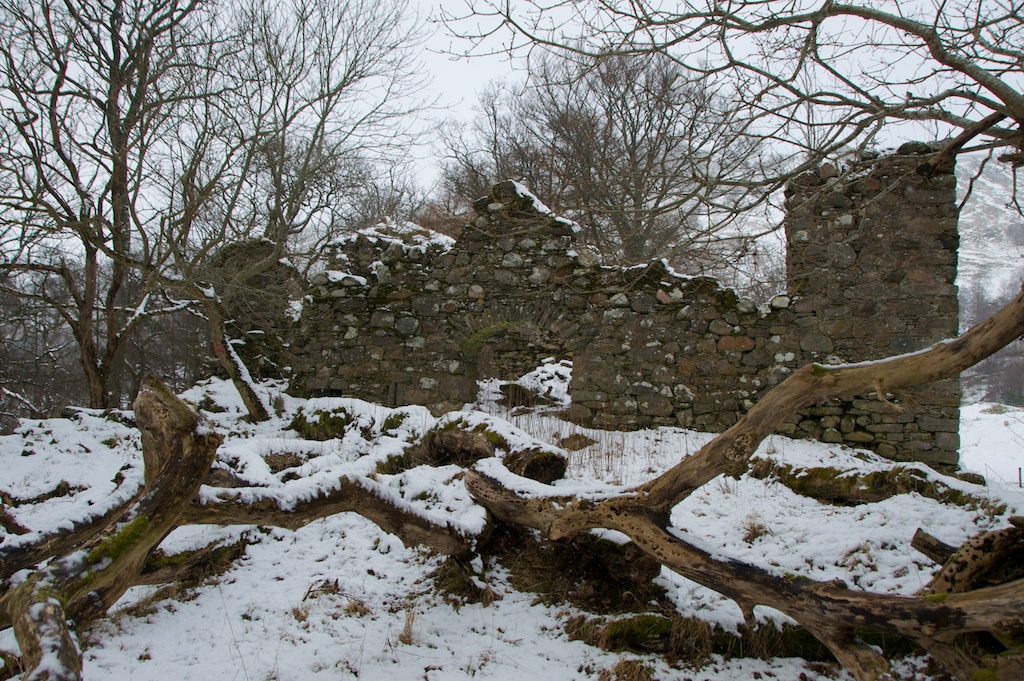
Carnbane Castle and a banquet for a bard
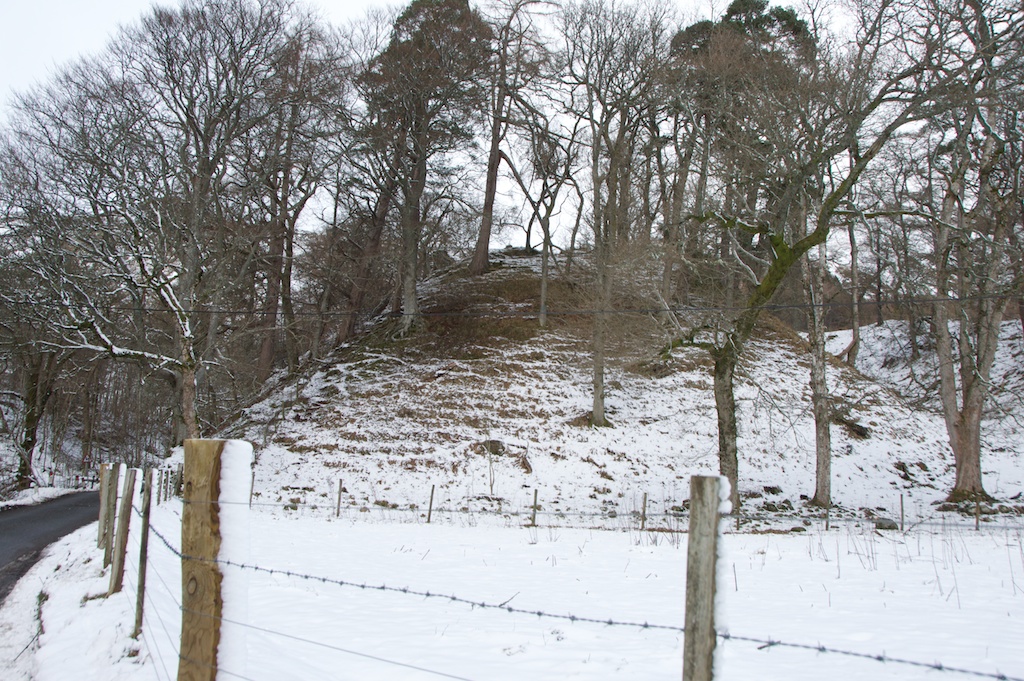 We were driving back out of Glenlyon, a long and winding valley above Loch Tay which is reputed – with some justification, I’d say – to be the most beautiful glen in Scotland. The sky was an almost surreal shade of blue, and the snow was scattering the sunlight into a million sparkling diamonds.
We were driving back out of Glenlyon, a long and winding valley above Loch Tay which is reputed – with some justification, I’d say – to be the most beautiful glen in Scotland. The sky was an almost surreal shade of blue, and the snow was scattering the sunlight into a million sparkling diamonds.
Glancing up through the trees as we came around a bend, we both noticed the broken walls of a building, half-hidden on the summit of a small wooded knoll. We pulled off the road, and I walked back to take a look, while Colin searched for beech mast – he needed reference for a new painting.
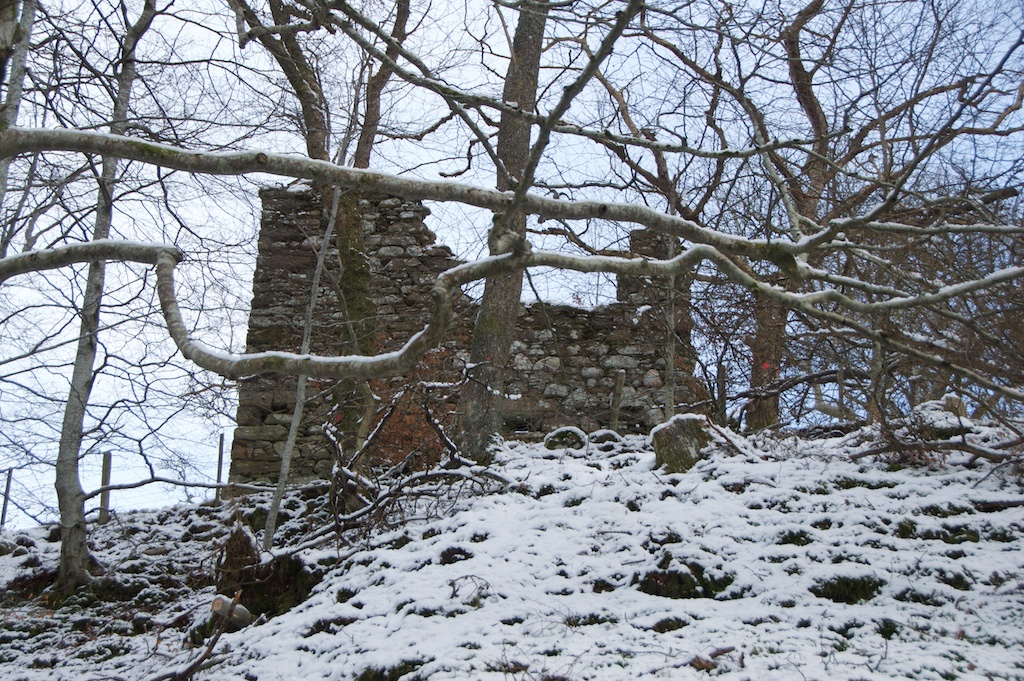 As I gazed at the ruins from below, I realised that taking pictures from that angle wouldn’t be enough. The hill looked a bit steep, but it certainly wasn’t high. I made it up there with more persistence than dignity, helped by a couple of handily-placed trees. The ground was extremely slippery, with snow overlying a thick layer of moss, grass and dead leaves.
As I gazed at the ruins from below, I realised that taking pictures from that angle wouldn’t be enough. The hill looked a bit steep, but it certainly wasn’t high. I made it up there with more persistence than dignity, helped by a couple of handily-placed trees. The ground was extremely slippery, with snow overlying a thick layer of moss, grass and dead leaves.
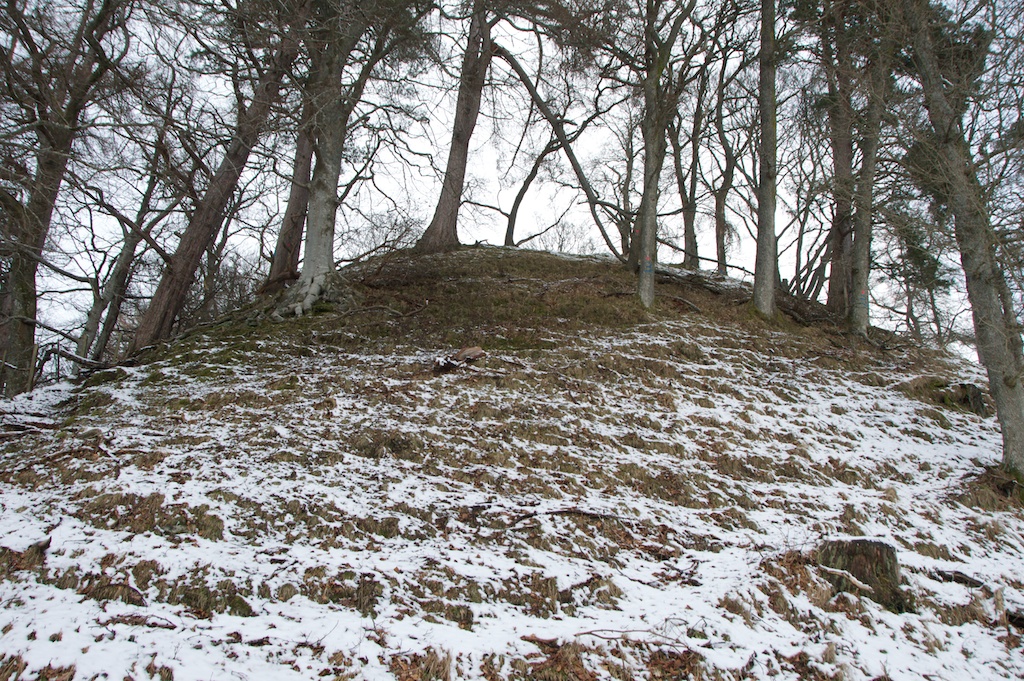
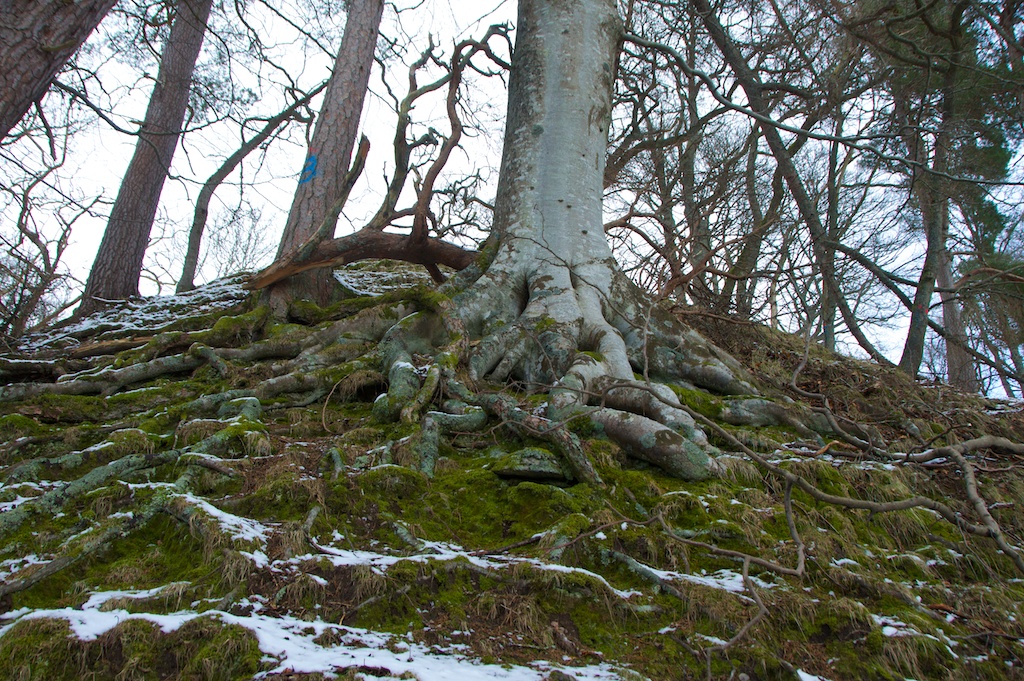
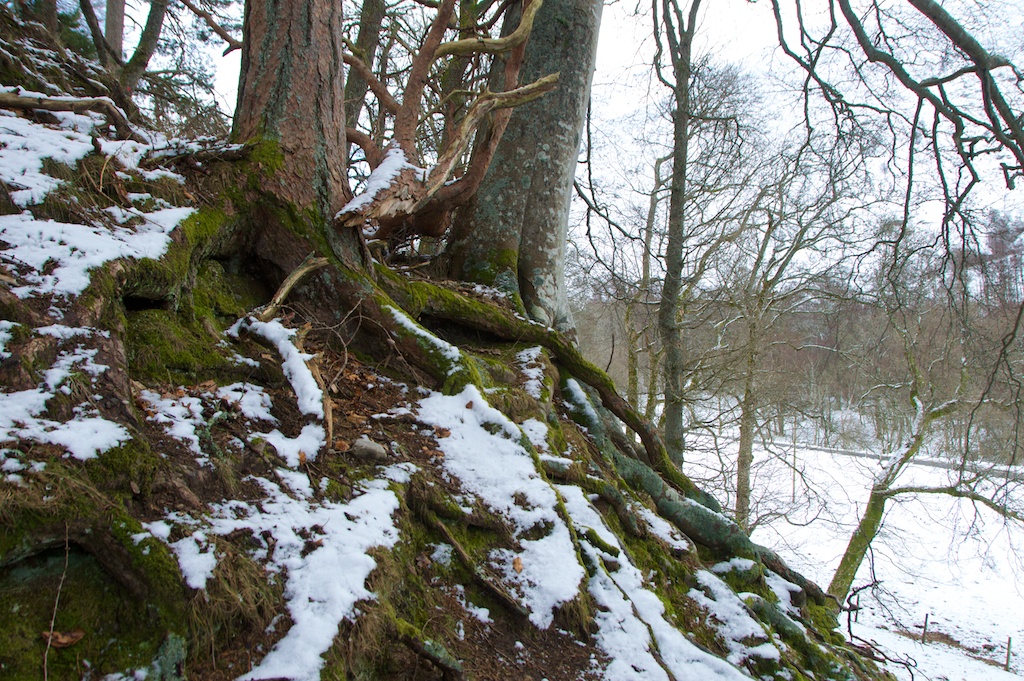
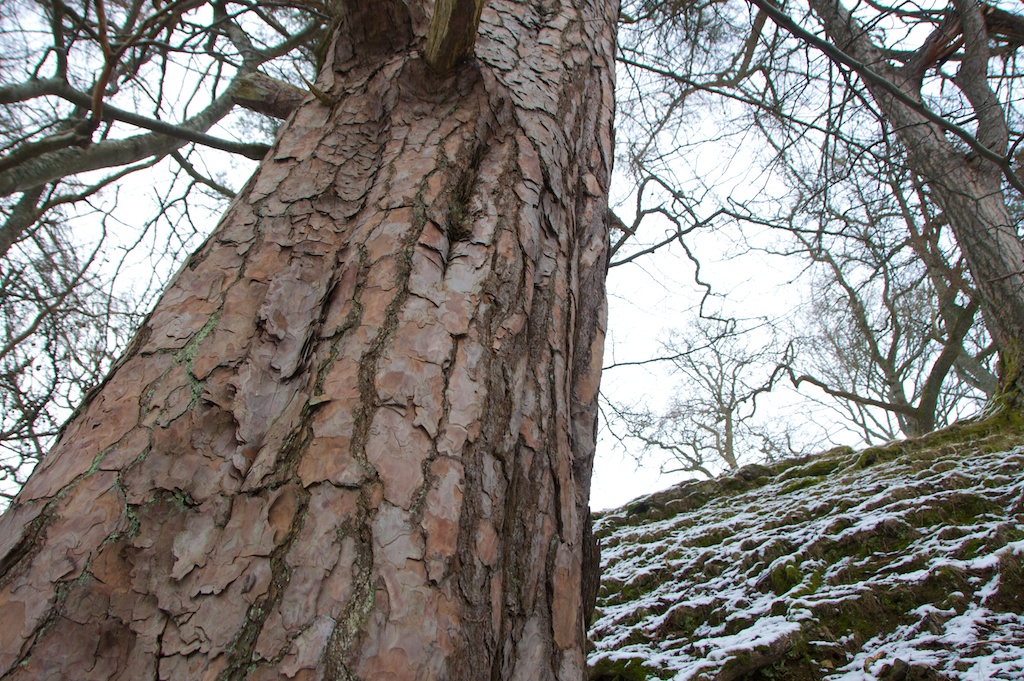 At the top, I found myself in what I assumed was the courtyard of a tower house; I was approaching the arched doorway from the east, like a visitor of old. Except that the lord, whoever he was, had long since departed.
At the top, I found myself in what I assumed was the courtyard of a tower house; I was approaching the arched doorway from the east, like a visitor of old. Except that the lord, whoever he was, had long since departed.
What was this place called, and who lived here? I was excited to find out. And the story is just as enchanting as I’d hoped.
“The second laird of the Campbell family was Donnachadh Ruadh na Feileachd, ‘Red Duncan of the Hospitality’. He died in the year 1580. His profuse hospitality gained for him a name not yet forgotten. Bands of Irish harpers came to Scotland in his days.”
‘Lairds of Glenlyon: Historical sketches, relating to the districts of Appin, Glenlyon and Breadalbane’ by Duncan Campbell, 1886
 This is Carnbane Castle, built around 1564 by a man called Red Duncan the Hospitable, a member of the Campbell family. Now, I’ve come across a couple of ‘Red’ and ‘Black’ Campbells in my travels and I wouldn’t be entirely convinced by the addition of ‘Hospitable’, but it seems that this one really did have a kind heart. He had a plentiful larder, as well: in the late 1500s, an old folk story says that an Irish bard visited Carnbane, and Duncan laid on a daily feast that consisted of “a fat bullock, and six wethers, with red deer and other game”.
This is Carnbane Castle, built around 1564 by a man called Red Duncan the Hospitable, a member of the Campbell family. Now, I’ve come across a couple of ‘Red’ and ‘Black’ Campbells in my travels and I wouldn’t be entirely convinced by the addition of ‘Hospitable’, but it seems that this one really did have a kind heart. He had a plentiful larder, as well: in the late 1500s, an old folk story says that an Irish bard visited Carnbane, and Duncan laid on a daily feast that consisted of “a fat bullock, and six wethers, with red deer and other game”.
As the story goes, when the time came for the bard to depart, it was noticed that his garments were ragged and thin. Perhaps he had a bit of a moan about leaving a warm hearth and venturing out into the cold! In any case, Duncan immediately took off all his own clothes and insisted that the Irishman should put them on. Having sent his guest on his way, Duncan made his way back up to his fortress, stark naked, and quite possibly a little chilly. The sight certainly surprised his wife, who exclaimed that he looked like a ‘large white goose’, from which the name ‘Carn Ban’ or ‘Bane’ is traditionally derived.*
* I know that ‘ban’ means ‘white’ in Gaelic, but I have yet to find that ‘carn’ means ‘goose’. If you can shed some light on this, please let me know!
Anyway, that wasn’t the end of the story.
The bard was cannier than he looked, and he returned the next day just to check whether Duncan’s lavish hospitality was just a pretence. But he was wrong: the laird of Carnbane had anticipated his return, and spread another generous feast in front of him. The bard stayed for another few days, and on his return to Ireland he sowed the seeds of a legend:
 “…when his own employer, Gorrie, inquired about Red Duncan, and put it to him if strangers fared not better with himself, the bard promptly replied :
“…when his own employer, Gorrie, inquired about Red Duncan, and put it to him if strangers fared not better with himself, the bard promptly replied :
Molar Gorrie thar a mhuir
Is gach duine na thir fein;
Ach na coimisear duine do t-sluagh
Ri Donnachadh Ruadh ach e fein.
Let Gorrie be praised over the sea,
and each man in his own country;
but let none of the race of men be compared
to Red Duncan but himself.”
‘Lairds of Glenlyon…‘ by Duncan Campbell
Red Duncan the Hospitable died in 1580, and soon afterwards the castle was destroyed by a party of Lochaber men, who were passing by and obviously nursing a long-standing grievance. They fired arrows of burning lint into the roof, and the hall-house was razed to the ground.
Carnbane Castle was never re-built, because Duncan’s successor, Colin Campbell, built a stronghold further down the glen, at Meggernie. Colin had his own unique set of problems, but Duncan’s reputation lives on:
“His laudations survive in the poetry both of Ireland and Scotland.”
‘Lairds of Glenlyon…’ by Duncan Campbell
Canmore describes Carnbane Castle as a ‘ruined hall-house with gun-loops’, and identifies the remains of a vaulted storage cellar and kitchen. In the south-western corner is a crumbled staircase tower, which would have led to the accommodation.
Having ducked underneath the arch, now partly blocked with vegetation and rubble, I found myself within the four walls – an unexpected guest, certainly too late for the feast. Looking through another opening on the opposite side, I could see quite a formidable drop down to the valley floor. The feeling was quite serene – happy, I would have said, without even knowing the history. I leaned against the wall, and after a few minutes a fine snow started to come down.
Looking at my photos now, and remembering the place, it’s a lovely to think that harp music once drifted around these walls, and that there was laughter and entertainment and a warm welcome within.
And another thing… the whole place seemed to be alive with wildlife. A couple of cock pheasants were racketing away in the woods, and some small birds – coal tits or treecreepers – flitted among the trees. A burst of song came from a hidden robin, and littering the ground outside the entrance were fallen branches, riddled with the holes of woodpeckers. Colin told me that a party of roe deer leapt away silently along the ridge shortly after I got up the hill.
I still had to get down, and since the slope seemed even steeper on the descent I just gave in to gravity and skidded down on my backside, which was afterwards extremely cold and wet. But this magical, hidden place is haunting, and in such a beautiful way. Perhaps it was the light reflecting off the snow, or the deep sense of peace, but I found it heart-lifting, and just the memory of it makes me smile.
Finding Carnbane Castle
 This is easier said than done, and when the leaves are on the trees it will be even harder! If you’re heading west, look for it on the right, about three miles after the turn-off from Fortingall into Glen Lyon; if you reach Invervar, you’ve gone past it, so turn around.
This is easier said than done, and when the leaves are on the trees it will be even harder! If you’re heading west, look for it on the right, about three miles after the turn-off from Fortingall into Glen Lyon; if you reach Invervar, you’ve gone past it, so turn around.
Sources:
- RCAHMS Canmore
- Lairds of Glenlyon: Historical sketches, relating to the districts of Appin, Glenlyon and Breadalbane’ by Duncan Campbell, 1886
- The Scottish Castles Association
- The Topographical, Statistical and Historical Gazetteer of Scotland, 1853
Photos copyright © Colin & Jo Woolf
Glen Lyon
The glen has links with Irish legend: “A chain of round towers stretches through its whole length, which the people still call ‘Caistealan nam Fiann’, castles of the Fingalians.” Duncan Campbell, 1886
There’s more to come… further up the glen is a standing stone with a very old story to tell! Meanwhile, just a stone’s throw away, you’ll find the ancient yew tree and stone circles of Fortingall.
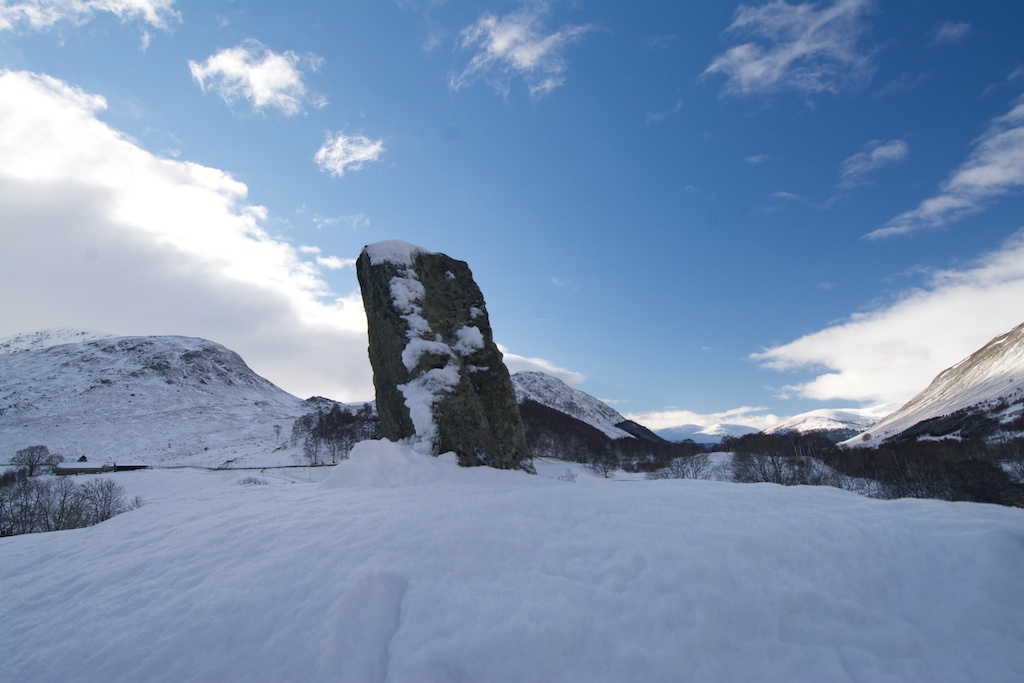

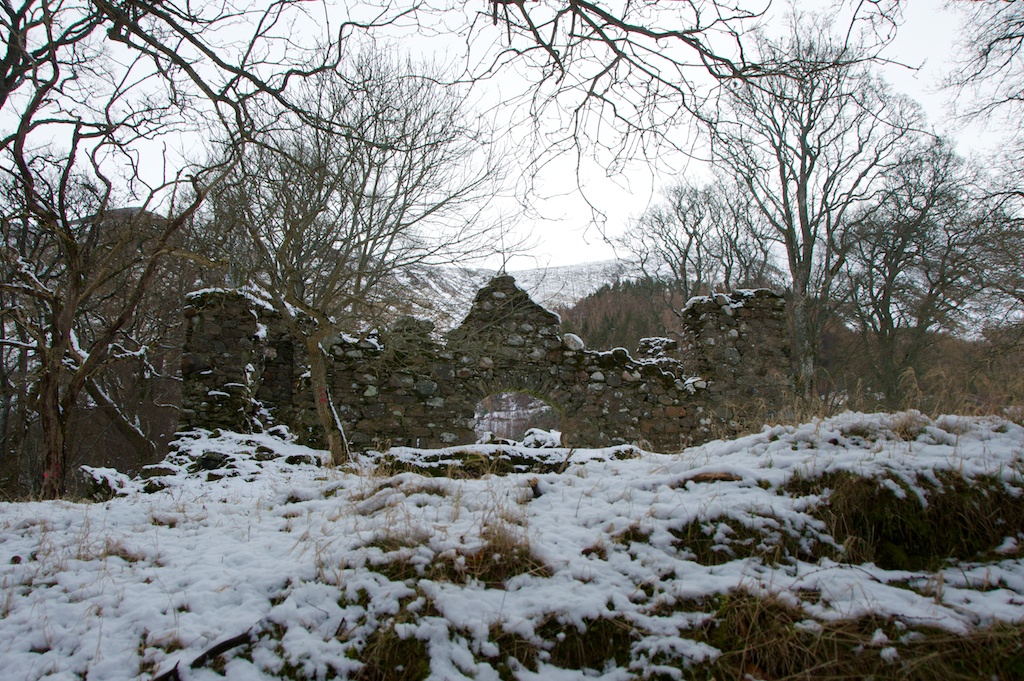
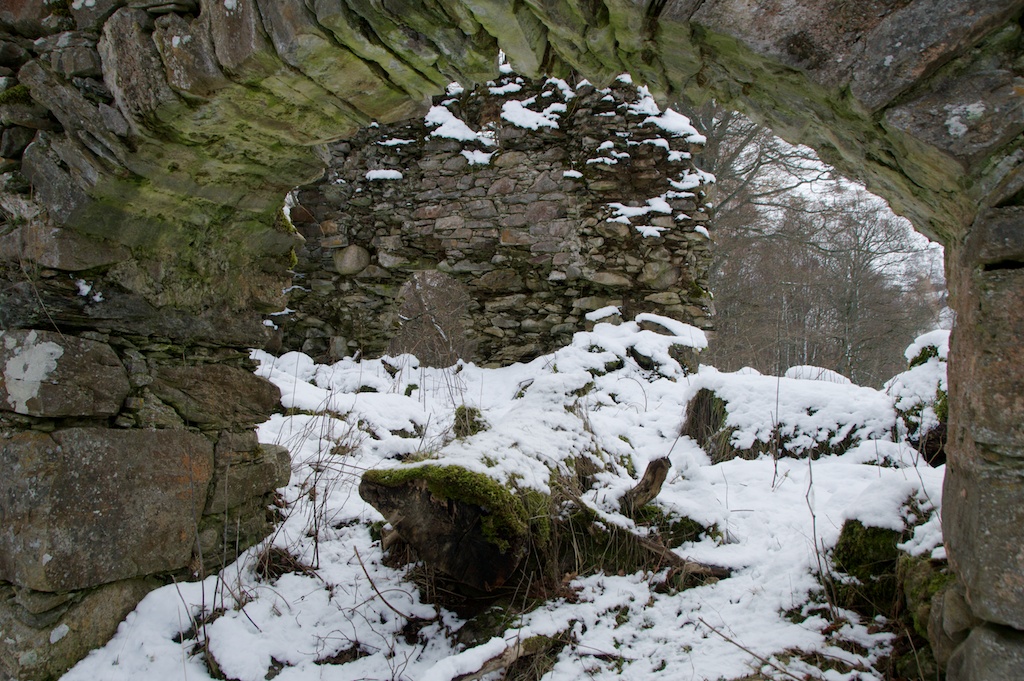
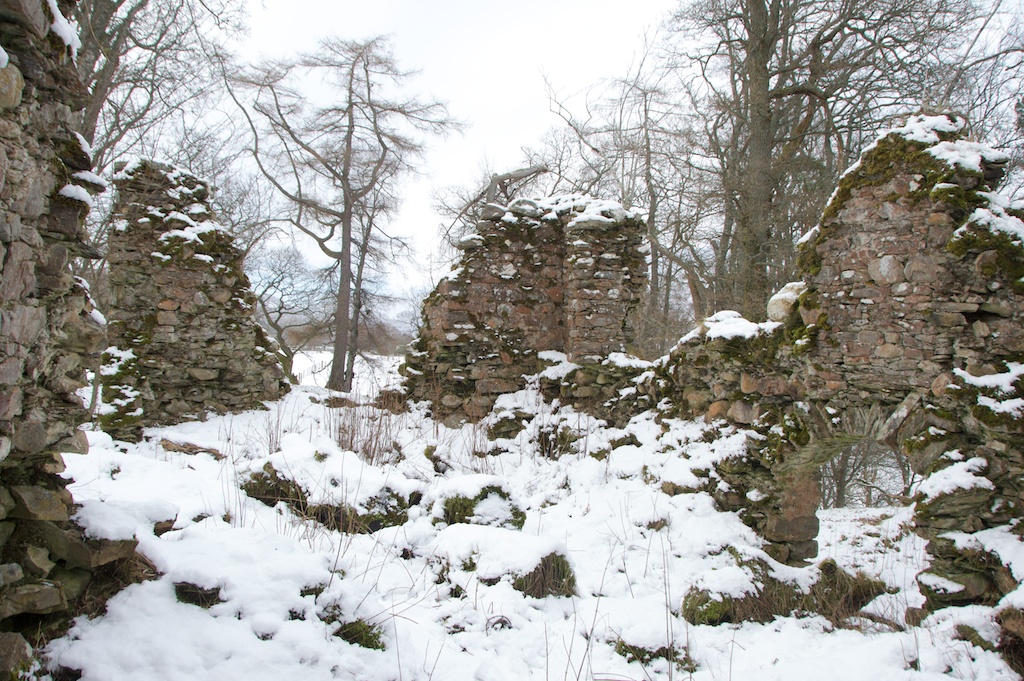
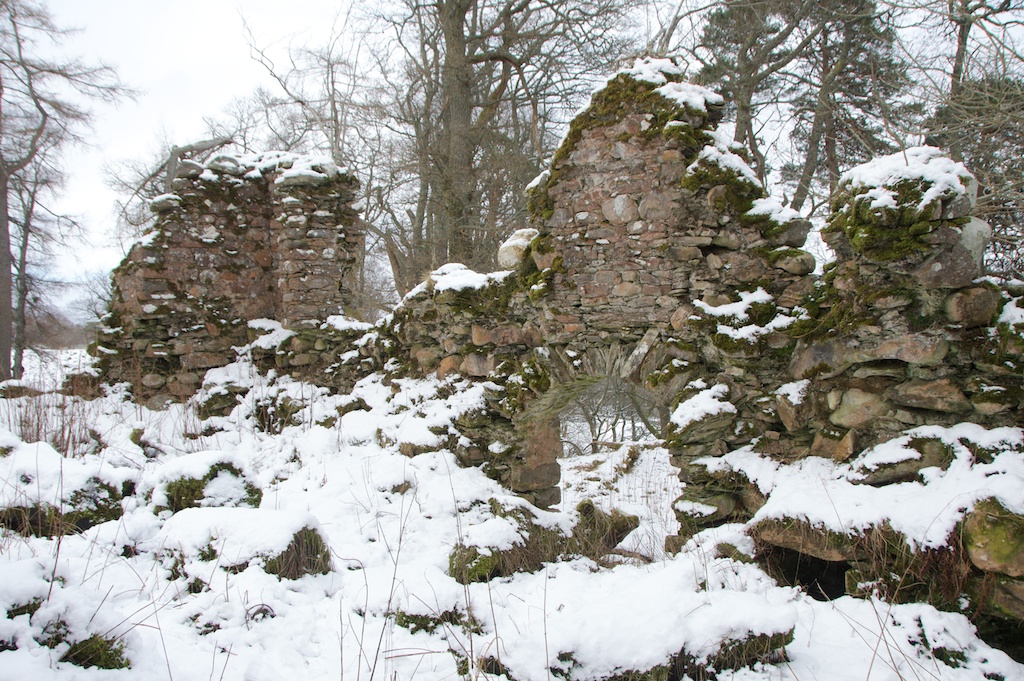
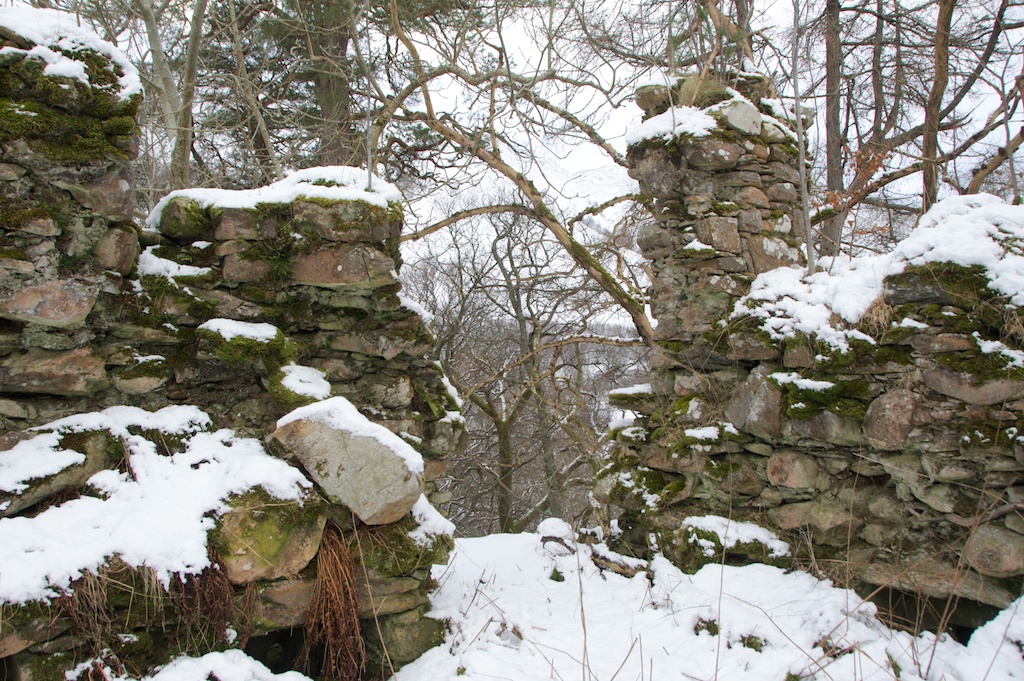
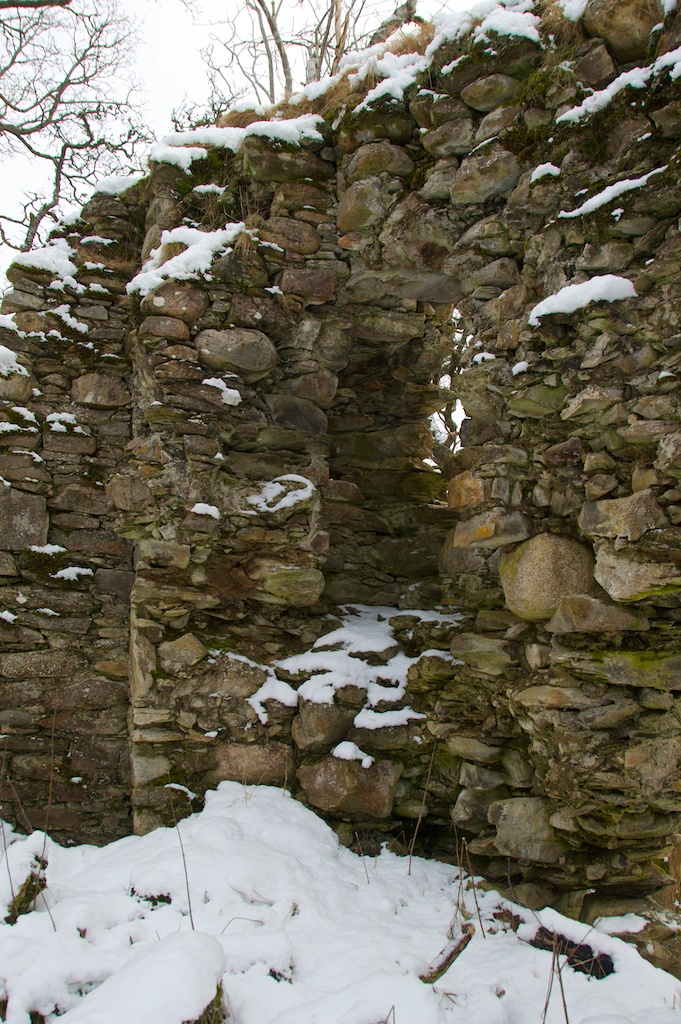
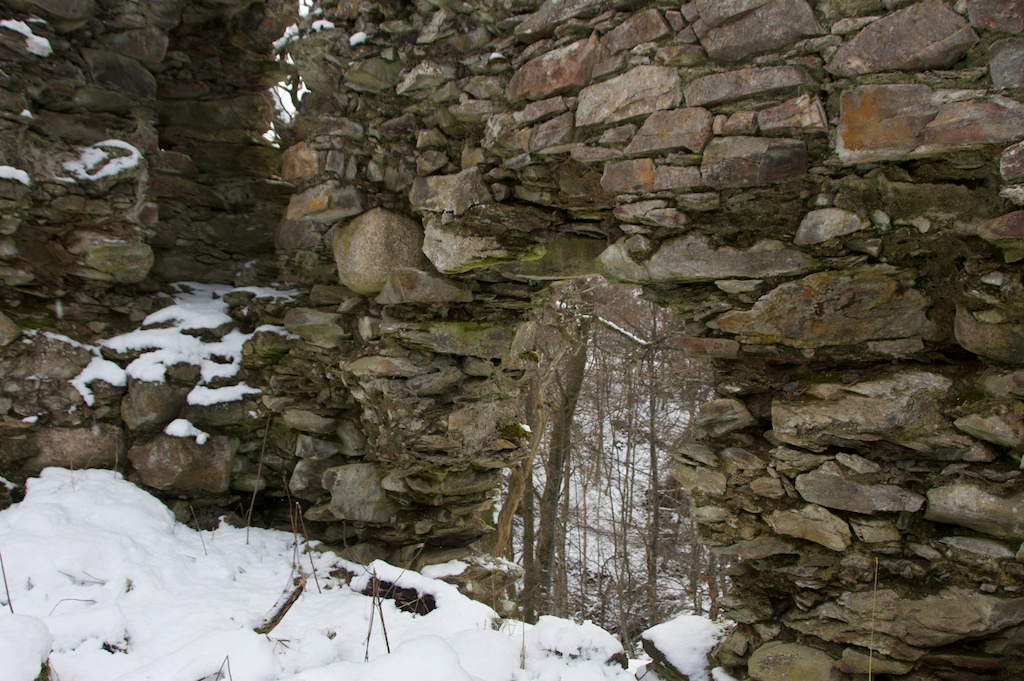
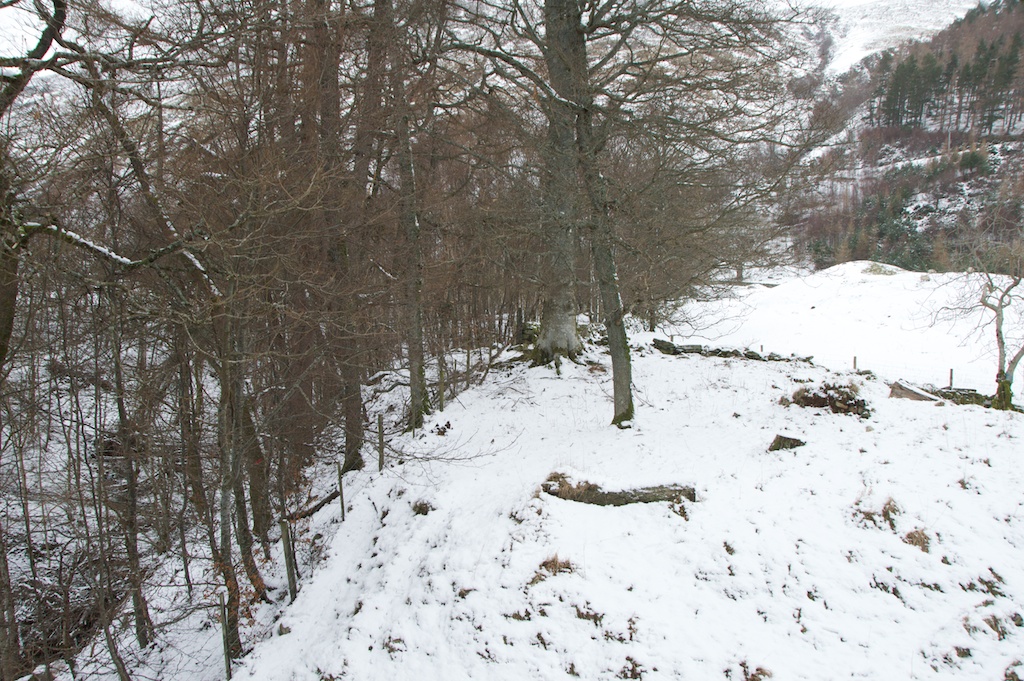
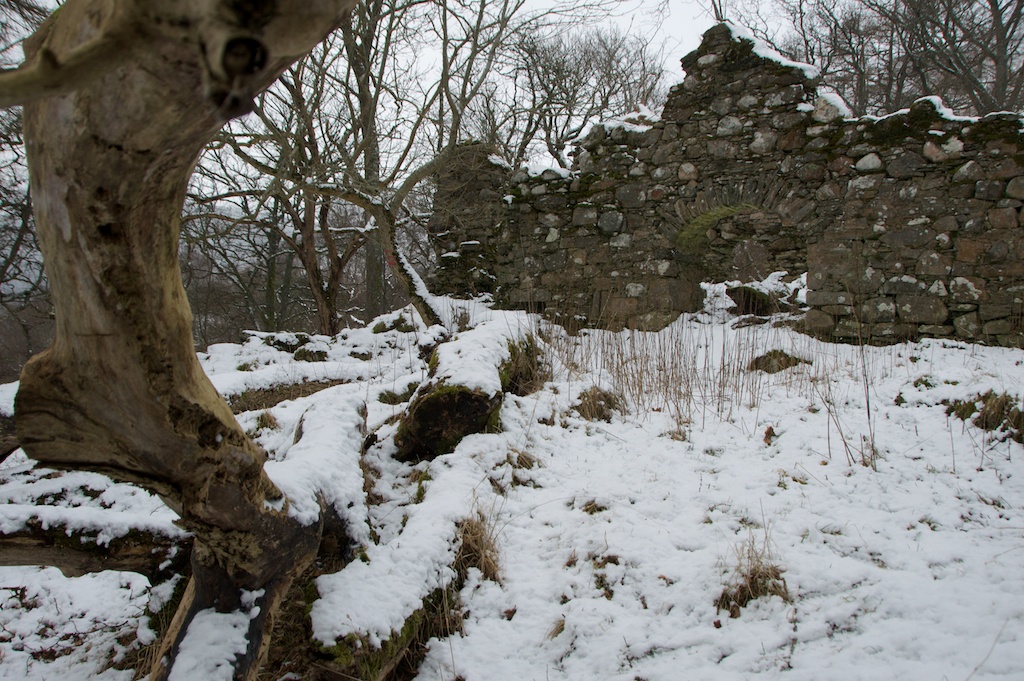
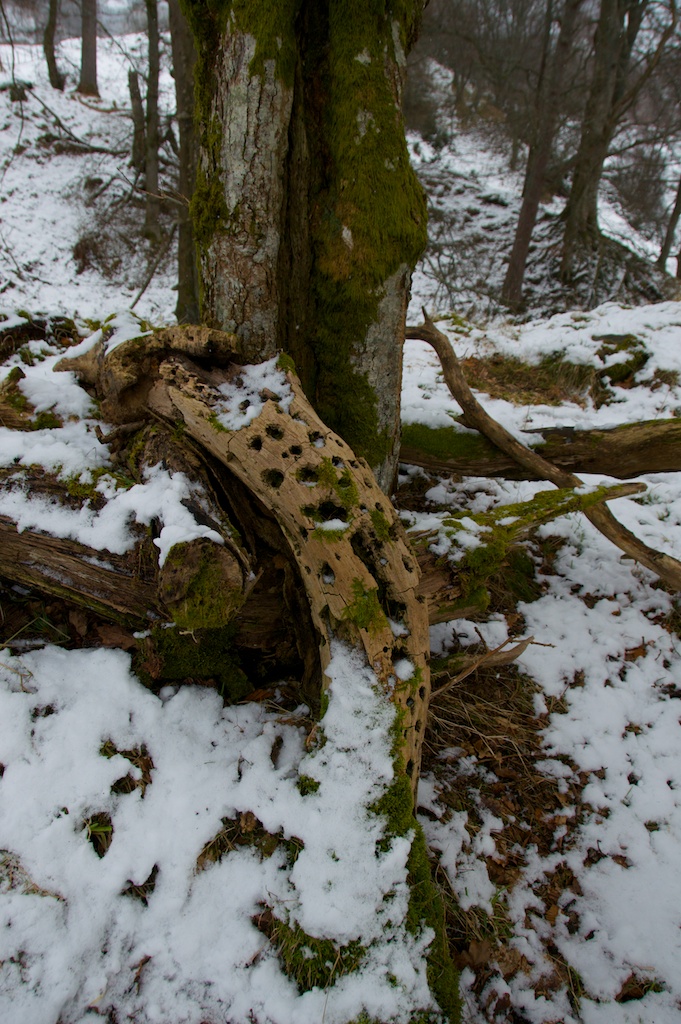
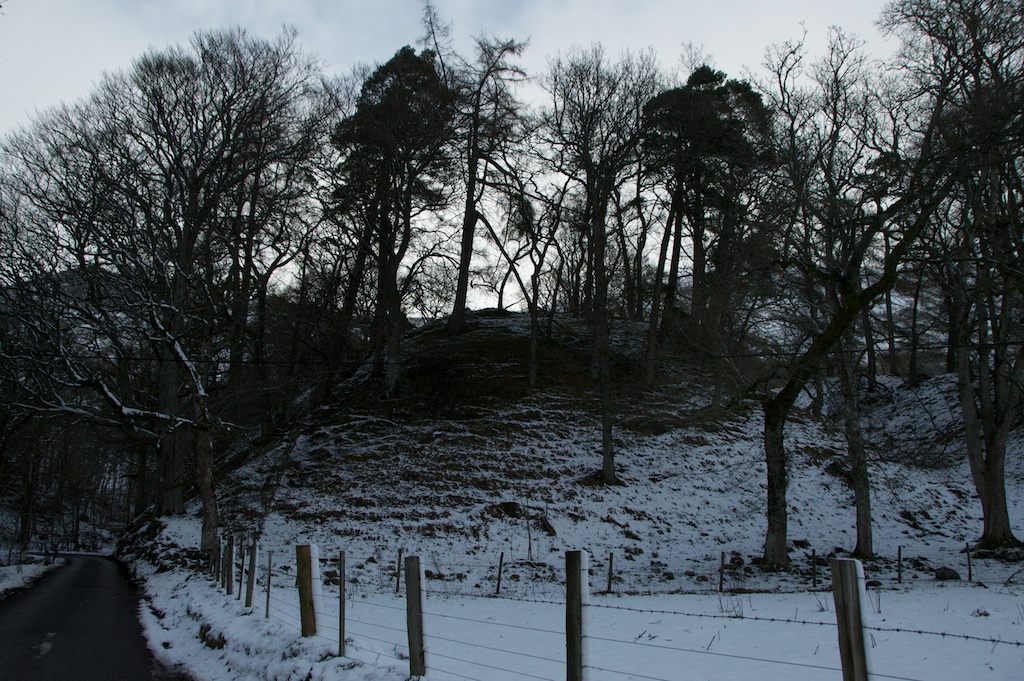
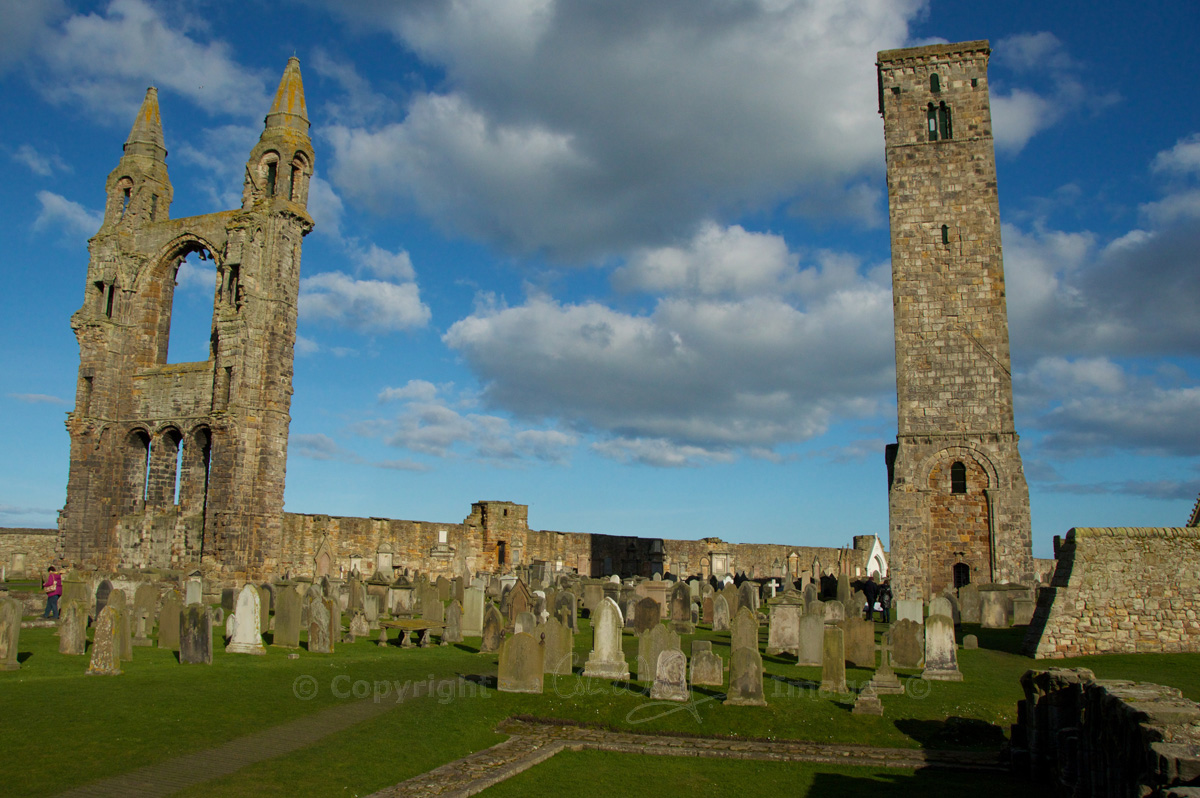
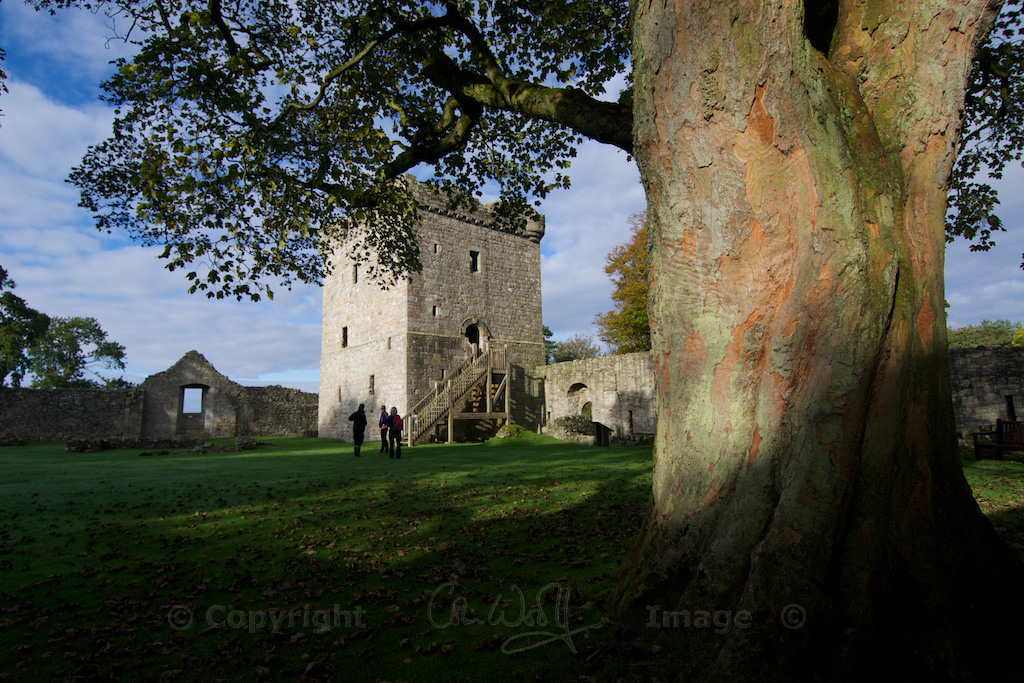
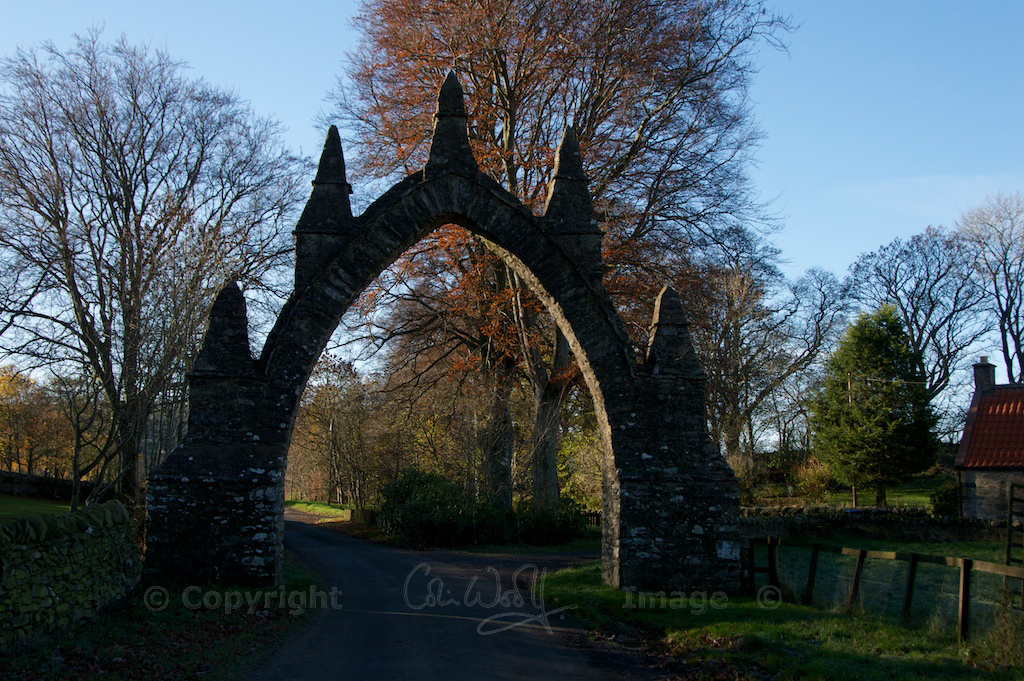
25 Comments
oglach
Lovely enchanting photos with a story to match. About the word ‘carn’; I’m not a language expert, but I’ve never heard that word used for goose in either Gaeilge or Gaelic. I know you know what a ‘cairn’ is; but I have heard Scottish people use the word ‘carn’ to describe something that is filthy. Sorry I couldn’t be of more help, thanks so much for your magical post.
Jo Woolf
Thank you! That’s interesting about ‘carn’, and any info is welcome. My instinct is that the place was possibly called ‘carn bane’ or ‘ban’ long before this story – maybe there was an earlier site on the knoll, because it looks just the sort of place for one. But that doesn’t mean the bit about Duncan’s wife isn’t true – she could easily have called him a ‘white goose’ – I’d like to believe it anyway! 🙂
davidoakesimages
Well that is one I do not have to add to the ‘to do list’…..we did struggle in late summer to discover the ruins…but we did!! Looks better in snow too.
Jo Woolf
Well done, David! I don’t think I’d have found them in summer. Yes, the snow really brought a lovely light to the place.
davidoakesimages
It was just a chance remark by a fellow traveller we met on the way…..just shows you have to take the time to stop and gossip.
Marie Macpherson
So interesting, Jo with fabulous photos. I’ve never heard carn used to mean filthy – and I thought I knew them all! Cac, keech, and the Gaelic for goose gheòidh so hill of the goose would be Càrn a’ Gheòidh. But the origin of so many place names are lost in legend. The fiction is more interesting than the fact! (Why let the facts get in the way of a good story!) thanks again!
Jo Woolf
Haha, my sentiments entirely! 🙂 Thank you for that, Marie!
Pat
Great pictures, Jo. And a warm, funny story! So nice to find a place that’s not dripping with tragedy. Glad you climbed the hill! 🙂
Jo Woolf
Thanks, Pat! Yes, a refreshing change! Duncan sounds like a decent kind of guy, although his cholesterol levels must have been a bit dangerous.
Debbie
So beautifully written and the pictures made me feel as if I was there too! What a humbling experience to be among walls with such history. So many times we stand in front of grand, in tact buildings and can see their beauty before us. But a ruin…..it says so much more. You find yourself imagining the family that lived there and the life they had. You realize as your standing inside the walls how you are now a small part of the history of this place. Thank you for sharing this memorable experience.
Jo Woolf
Thank you very much, Debbie! You are most welcome. It was a lovely thing to be able to share it. Yes, I love undisturbed ruins like this one… they do speak in ways that ‘restored’ ones don’t.
Jeff Campbell
A very good Duncan as opposed to black Duncan. He was such a bastard.
Jo Woolf
Yes… I came across Black Duncan at Loch Dochart Castle last year. Good to see he had at least one nice relative!
blosslyn
Looks lovely in the snow, lovely snow photos 🙂
Jo Woolf
Thanks, Lynne – yes, perfect conditions for photography.
http://vivinfrance.wordpress.com
A fascinating story and lovely pictures. A hospitable Campbell was a rare thing in those days!
But those pictures tell a different story as to why the castle is in ruins: Jock (who knows about these things, having built our stone house in the 90’s) always quotes “Ne’er set a stane upon a stane. Set ane above twa” from the old man who taught masonry at his school. If you look closely at your pictures, you will see lots of vertical lines in the walls where ane stane has been set on ane, which makes for a weak wall.
Jo Woolf
Thank you, Viv! I loved the story, too. Glad to know that this one was a good guy! I do see what you mean about some of the walls. They were 5 feet thick, though!
JennyOH
I’ll echo the other comments about how nice it was to read a story of a kind lord with a hall full of cheer! Sad that it was ended violently, but it seems to be a lovely, peaceful place today. What a nice chance find! I love the mosses and twisted roots.
Jo Woolf
So true, Jenny! I enjoyed finding out about Duncan and his kindness as well. I loved all those trees too, with their twisted roots which seemed to be holding hands, if that isn’t too weird an analogy! A lovely feeling about this place. Thanks for your nice comment.
Glenlyon Campbell
In the summer of 2014 I toured Glenlyon, the home of my Campbell ancestors. I’m sorry I missed the ruins of Carnbane Castle. Now I have a reason to return. Speaking on behalf of Duncan’s descendants on the West Coast of Canada. We are still very “hospitable.”
Jo Woolf
That’s so good that you have a reason to return! And good to know that the hospitality is being continued! 🙂 Lovely to hear from you and thanks for your comment. I hope you will come back to Glen Lyon soon.
Alexander Menzies
It’s sad arriving late at a party. Four years late. Some of my ancestors lived at Carnbanmor, just west of the castle. Their journals record happy and sad times but they were always looking out for more land which had to come from Canada and Australia in the 19th century.
I’ve revisited Carnban (I spell it without the “e”) many times (including just months ago) and wonder how much longer the front entrance arch will last and what can be done to prolong its life. The flaming McDonald arrow was unfortunate, although some might say Duncan Campbell eventually had his revenge in the latter part of the next century..
Carnban Castle shares a precarious existence with other notable structures in Glenlyon; the Stone of the Sandals (1488), St Adamnan’s Cross (~700), the walled graveyard near Invervar (recently in shameful neglect).. the list is long.
Alexander Menzies of Culdares
Jo Woolf
Dear Alexander, You’re most welcome to the ‘party’, and it’s lovely to hear from you! Fascinating to know about your connection with Carnban(e). Are there still visible remains of Carnbanmor? I’m interested to hear about the Stone of the Sandals, and the graveyard near Invervar, which I’ll have to look up. Glen Lyon is so rich in history! We so much enjoyed our visit there, in the snow. Incidentally, I think I have mentioned one of your forebears in my book ‘British Trees’ – Col James Menzies, who brought larch trees from Austria? With all good wishes, Jo
Alexander Menzies
Dear Jo, Your reply came as a complete surprise, I was thinking my comment would suffer the fate of a note in a bottle awaiting discovery on a long abandoned beach )). Thank you.
I’ll make this reply brief as I need to first get properly acquainted with your site. Indeed, the work of James Menzies is still extant in Glenlyon nearer the entrance around Chesthill. I was at North Chesthill back in October and both there and Chesthill (East) remain magnificent properties with their various tree species in park-like settings.
I’m most interested in learning more of your “British Trees” publication.
Carnbanmor is still outlined by extensive foundations, some for various dwellings and farm shelters as well as animal enclosures.
The Stone of the Sandals is a 1488 battle site (Stewarts v. McIvors) near Rusgich; it’s unmarked but being so close to the road (and on a corner) may well someday suffer from ‘inadvertent” bulldozing.
More of that later,
Thank you for the quick reply I look forward to making further contact in the near future (CV-19 willing..),
Alexander Menzies.
Jo Woolf
Excellent – look forward to hearing more from you! You could either reply here, or email me: jo@thehazeltree.co.uk Meanwhile I hope I’ve restored your faith in messages in a bottle! 😀 Jo